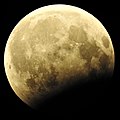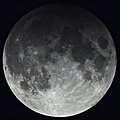| Total eclipse | |||||||||||||||||
 View from Olympia, Washington, just after 7:00 UTC | |||||||||||||||||
| Date | March 14, 2025 | ||||||||||||||||
|---|---|---|---|---|---|---|---|---|---|---|---|---|---|---|---|---|---|
| Gamma | 0.3485 | ||||||||||||||||
| Magnitude | 1.1804 | ||||||||||||||||
| Saros cycle | 123 (53 of 72) | ||||||||||||||||
| Totality | 66 minutes, 3.9 seconds | ||||||||||||||||
| Partiality | 218 minutes, 55.8 seconds | ||||||||||||||||
| Penumbral | 363 minutes, 22.4 seconds | ||||||||||||||||
| |||||||||||||||||
A total lunar eclipse occurred at the Moon's descending node of orbit on Friday, March 14, 2025, [1] with an umbral magnitude of 1.1804. A lunar eclipse occurs when the Moon moves into the Earth's shadow, causing the Moon to be darkened. A total lunar eclipse occurs when the Moon's near side entirely passes into the Earth's umbral shadow. Unlike a total solar eclipse, which can only be viewed from a relatively small area of the world, a lunar eclipse may be viewed from anywhere on the night side of Earth. A total lunar eclipse can last up to nearly two hours, while a total solar eclipse lasts only a few minutes at any given place, because the Moon's shadow is smaller. Occurring about 3.3 days before apogee (on March 17, 2025, at 12:35 UTC), the Moon's apparent diameter was smaller. [2]
Contents
This lunar eclipse was the first of an almost tetrad, with the others being on September 8, 2025 (total); March 3, 2026 (total); and August 28, 2026 (partial).
This eclipse was seen from the surface of the Moon by Firefly Aerospace's Blue Ghost Mission 1 lander, which captured images of the ring of light around the Earth as the Sun passed behind it and the red glow on the Moon's surface. [3] [4]
















